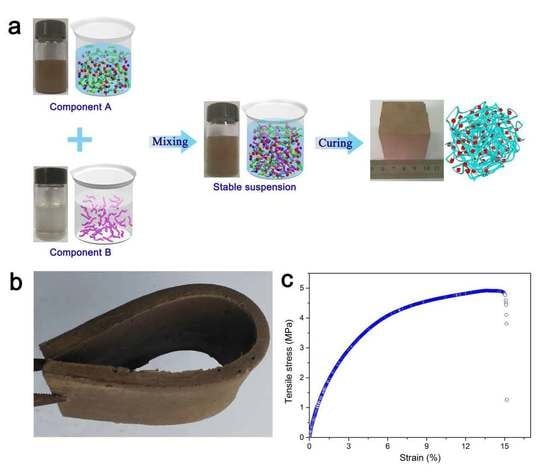Polyurethane/Red Mud Composites with Flexibility, Stretchability, and Flame Retardancy for Grouting
Abstract
:1. Introduction
2. Experimental
2.1. Materials
2.2. Preparation of PRC Grouting Material
2.3. Characterization
2.4. Mechanical Measurements
3. Results and Discussion
4. Conclusions
Supplementary Materials
Author Contributions
Funding
Conflicts of Interest
References
- De Santis, S.; Ceroni, F.; de Felice, G.; Fagone, M.; Ghiassi, B.; Kwiecien, A.; Lignola, G.P.; Morganti, M.; Santandrea, M.; Valluzzi, M.R.; et al. Round robin test on tensile and bond behaviour of steel reinforced grout systems. Compos. Part B Eng. 2017, 127, 100–120. [Google Scholar] [CrossRef]
- De Santis, S. Bond behaviour of steel reinforced grout for the extrados strengthening of masonry vaults. Constr. Build. Mater. 2017, 150, 367–382. [Google Scholar] [CrossRef]
- El Tani, M.; Stille, H. Grout spread and injection period of silica solution and cement mix in rock fractures. Rock Mech. Rock Eng. 2017, 50, 2365–2380. [Google Scholar] [CrossRef]
- Zhang, J.; Weng, X.Z.; Yang, B.H.; Li, Y.F.; Liu, J.Z.; Jiang, L. Bonding characteristics of grouting layer in prefabricated cement concrete pavement. Constr. Build. Mater. 2017, 145, 528–537. [Google Scholar] [CrossRef]
- Li, Q.T.; Liu, L.J.; Huang, Z.H.; Yuan, G.L. Residual compressive strength of cement-based grouting material with early ages after fire. Constr. Build. Mater. 2017, 138, 316–325. [Google Scholar] [CrossRef]
- Park, K.; Kim, D. Analysis of homogel uniaxial compression strength on bio grouting material. Materials 2016, 9, 244. [Google Scholar] [CrossRef] [PubMed]
- Kim, D.; Park, K. Evaluation of the grouting in the sandy ground using bio injection material. Geomech. Eng. 2017, 12, 739–752. [Google Scholar] [CrossRef]
- Liao, H.J.; Su, S.F. Base stability of grout pile–reinforced excavations in soft clay. J. Geotech. Geoenviron. 2012, 138, 184–192. [Google Scholar] [CrossRef]
- Xiang, X.J.; Qian, J.W.; Bai, Y.X.; Yang, W.Y.; Qian, X.Q.; Fang, M.H. Synthesis and properties of elastomeric polyurethane for grouting. J. Polym. Mater. 2005, 22, 219–226. [Google Scholar]
- Wei, Y.; Wang, F.M.; Gao, X.; Zhong, Y.H. Microstructure and fatigue performance of polyurethane grout materials under compression. J. Mater. Civ. Eng. 2017, 29, 0401710. [Google Scholar] [CrossRef]
- Lopez-Anido, R.; Michael, A.P.; Sandford, T.C. Fiber reinforced polymer composite-wood pile interface characterization by push-out tests. J. Compos. Constr. 2017, 8, 360–368. [Google Scholar] [CrossRef]
- Anagnostopoulos, C.A.; Papaliangas, T.T. Experimental investigation of epoxy resin and sand mixes. J. Geotech. Geoenviron. 2012, 138, 841–849. [Google Scholar] [CrossRef]
- Besse, V.; Le Pluart, L.; Cook, W.D.; Pham, T.N.; Madec, P.J. Synthesis and polymerization kinetics of acrylamide phosphonic acids and esters as new dentine adhesives. J. Polym. Sci. Pol. Chem. 2013, 51, 149–157. [Google Scholar] [CrossRef]
- Heinzmann, C.; Salz, U.; Moszner, N.; Fiore, G.L.; Weder, C. Supramolecular cross-links in poly(alkyl methacrylate) copolymers and their impact on the mechanical and reversible adhesive properties. ACS Appl. Mater. Interfaces 2015, 7, 13395–13404. [Google Scholar] [CrossRef] [PubMed]
- Wei, T.; Zhang, D.; Chen, L. The kinetics study and reaction mechanism of acrylate grouting materials. Constr. Build. Mater. 2015, 47, 89–92. [Google Scholar]
- Dongre, P.; Driscoll, M.; Amidon, T.; Bujanovic, B. Lignin-furfural based adhesives. Energies 2015, 8, 7897–7914. [Google Scholar] [CrossRef]
- Zain, N.M.; Ahmad, S.H.; Ali, E.S. Durability of green polyurethane adhesive bonded aluminum alloy in dry and hydrothermal ageing conditions. J. Appl. Polym. Sci. 2014, 131, 41151. [Google Scholar] [CrossRef]
- Huang, J.J.; Sun, J.Y.; Zhang, R.Y.; Liu, X.P.; Yang, Z.H.; Yuan, T. Improvement of biodegradability of UV-curable adhesives modified by a novel polyurethane acrylate. Prog. Org. Coat. 2016, 95, 20–25. [Google Scholar] [CrossRef]
- Gutiérrez-González, S.; Gadea, J.; Rodríguez, A.; Junco, C.; Calderón, V. Lightweight plaster materials with enhanced thermal properties made with polyurethane foam wastes. Constr. Build. Mater. 2012, 28, 653–658. [Google Scholar] [CrossRef]
- Orgilés-Calpena, E.; Arán-Aís, F.; Torró-Palau, A.M.; Montiel-Parreño, E.; Orgilés-Barceló, C. Synthesis of polyurethanes from CO2-based polyols: A challenge for sustainable adhesives. Int. J. Adhes. Adhes. 2016, 67, 63–68. [Google Scholar] [CrossRef]
- Sung, G.; Gwon, J.G.; Kim, J.H. Characteristics of polyurethane adhesives with various uretonimine contents in isocyanate and average alcohol functionalities. J. Appl. Polym. Sci. 2016, 133, 43737. [Google Scholar] [CrossRef]
- Xiang, X.J.; Qian, J.W.; Yang, W.Y.; Fang, M.H.; Qian, X.Q. Synthesis and properties of nanosilica-reinforced polyurethane for grouting. J. Appl. Polym. Sci. 2006, 100, 4333–4337. [Google Scholar] [CrossRef]
- Yang, Z.P.; Zhang, X.F.; Liu, X.; Guan, X.M.; Zhang, C.J.; Niu, Y.T. Polyglycerol-based organic-inorganic hybrid adhesive with high early strength. Mater. Des. 2017, 117, 1–6. [Google Scholar] [CrossRef]
- Hong, X.D.; Dong, W.; Yang, S.B.; Mu, B.Y.; Liang, B. Study on structure and performance of reactive silicate reinforced polyurethane composite. Polym. Eng. Sci. 2015, 55, 2322–2327. [Google Scholar] [CrossRef]
- Yang, Z.P.; Zhang, W.J.; Guan, X.M.; Zhang, C.J. Preparation, characterization, and properties of silicate/polyurethaneurea composites based on dipropylene glycol dibenzoate. Polym. Compos. 2016, 37, 37–43. [Google Scholar] [CrossRef]
- Mymrin, V.; Guidolin, M.A.; Klitzke, W.; Alekseev, K.; Guidolin, R.H.; Avanci, M.A.; Pawlowsky, U.; Winter, E.; Catai, R.E. Environmentally clean ceramics from printed circuit board sludge, red mud of bauxite treatment and steel slag. J. Clean. Prod. 2017, 164, 831–839. [Google Scholar] [CrossRef]
- Oliveira, A.A.S.; Costa, D.S.; Teixeira, I.F.; Parreira, L.A.; Menini, L.; Gusevskaya, E.V.; Moura, F.C.C. Red mud based gold catalysts in the oxidation of benzyl alcohol with molecular oxygen. Catal. Today 2017, 289, 89–95. [Google Scholar] [CrossRef]
- Yang, J.K.; Song, J.; Liang, S.; Guan, R.N.; Shi, Y.F.; Yu, W.B.; Zhu, S.Y.; Fan, W.; Hou, H.J.; Hu, J.P.; et al. Synergistic effect of water content and composite conditioner of Fenton’s reagent combined with red mud on the enhanced hydrogen production from sludge pyrolysis. Water Res. 2017, 123, 378–387. [Google Scholar] [CrossRef] [PubMed]
- Amritphale, S.S.; Anshul, A.; Chandra, N.; Ramakrishnan, N. A novel process for making radiopaque materials using bauxite-red mud. J. Eur. Cram. Soc. 2017, 27, 1945–1951. [Google Scholar] [CrossRef]
- Li, J.; Xu, L.; Sun, P.P.; Zhai, P.Y.; Chen, X.P.; Zhang, H.; Zhang, Z.S.; Zhu, W.C. Novel application of red mud: Facile hydrothermal-thermal conversion synthesis of hierarchical porous AlOOH and Al2O3 microspheres as adsorbents for dye removal. Chem. Eng. J. 2017, 321, 622–634. [Google Scholar] [CrossRef]
- Kazak, O.; Tor, A.; Akin, I.; Arslan, G. Preparation and characterization of novel polysulfone-red mud composite capsules for the removal of fluoride from aqueous solutions. RSC Adv. 2016, 6, 86673–86681. [Google Scholar] [CrossRef]
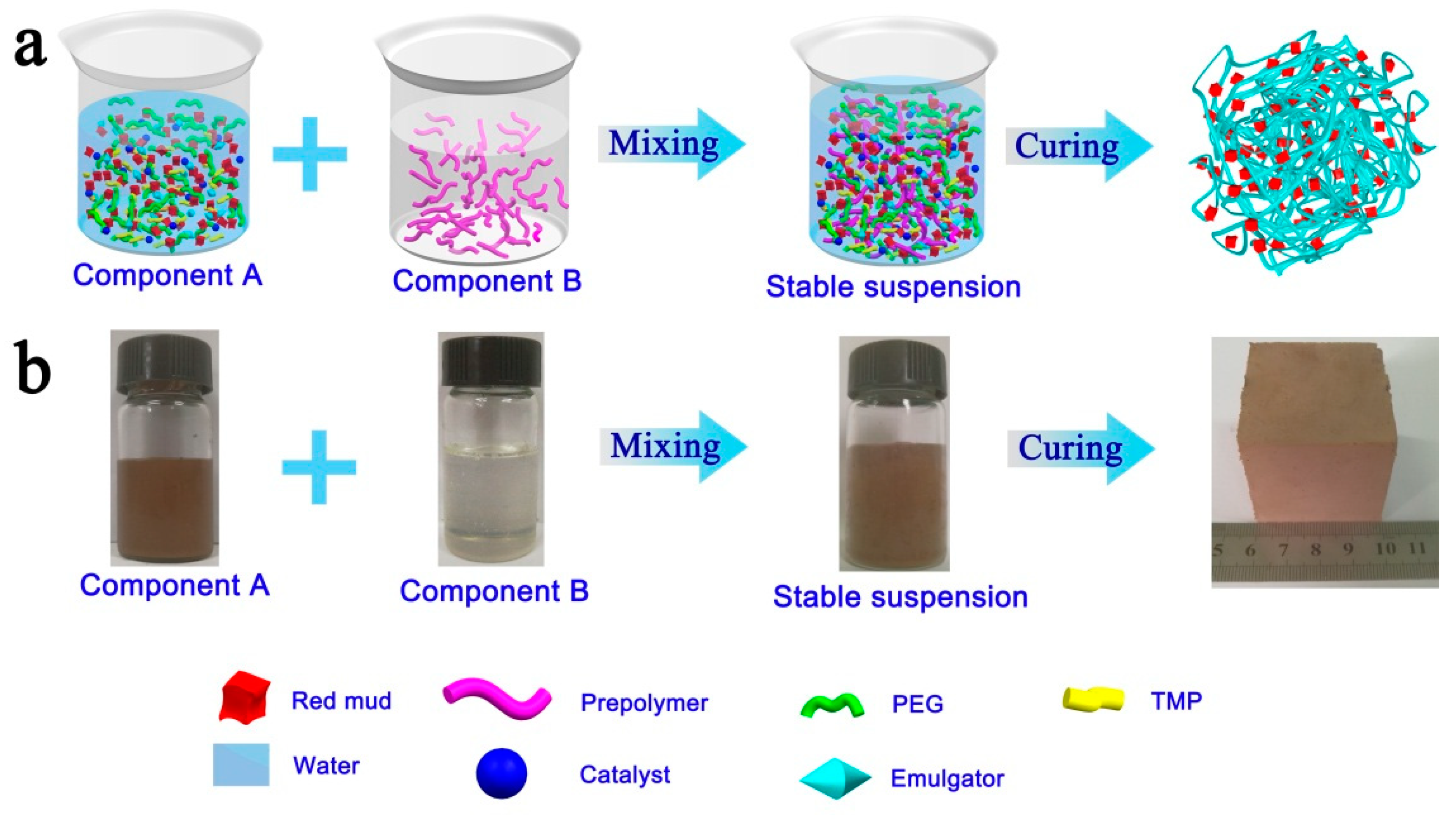
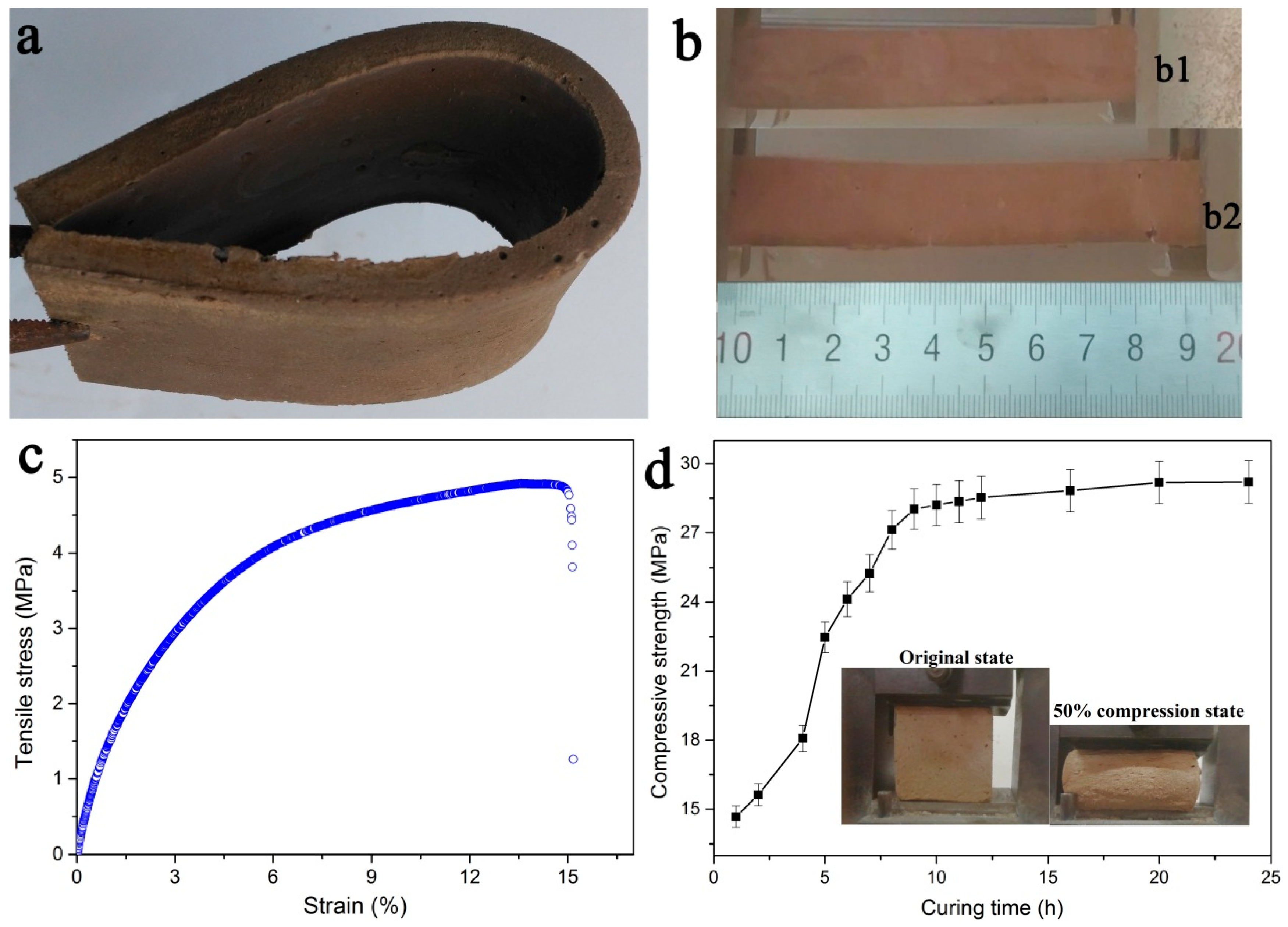


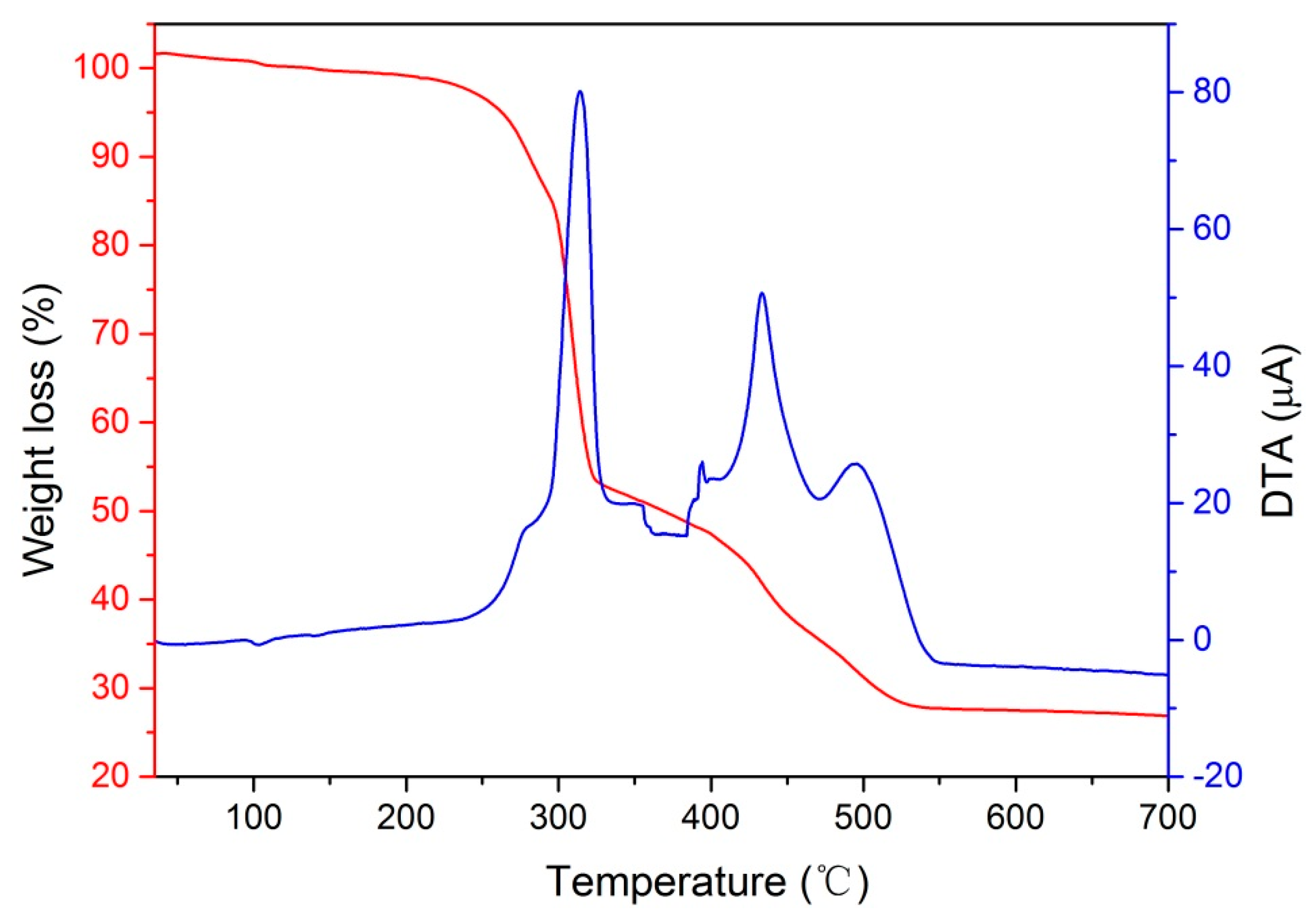
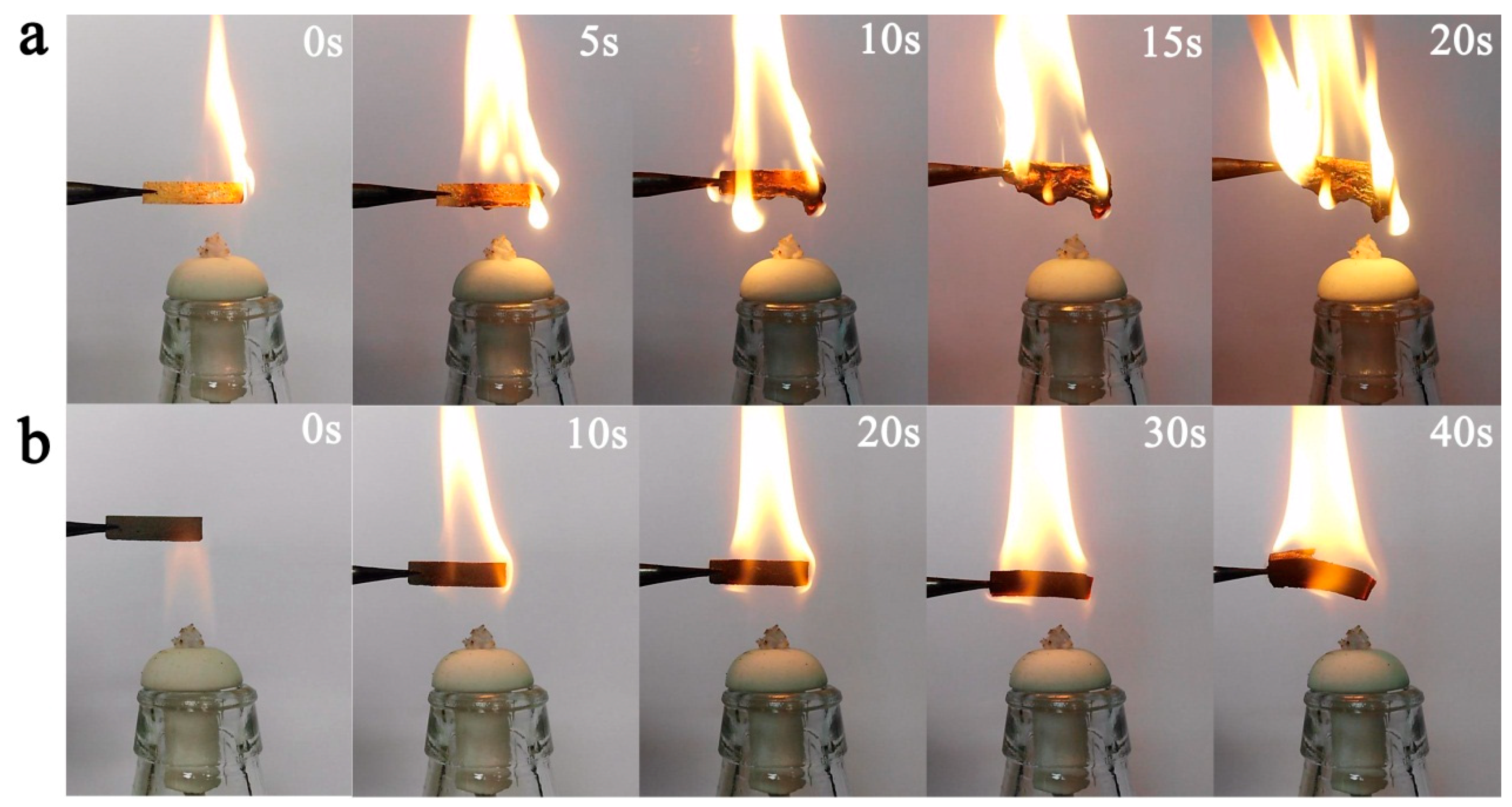
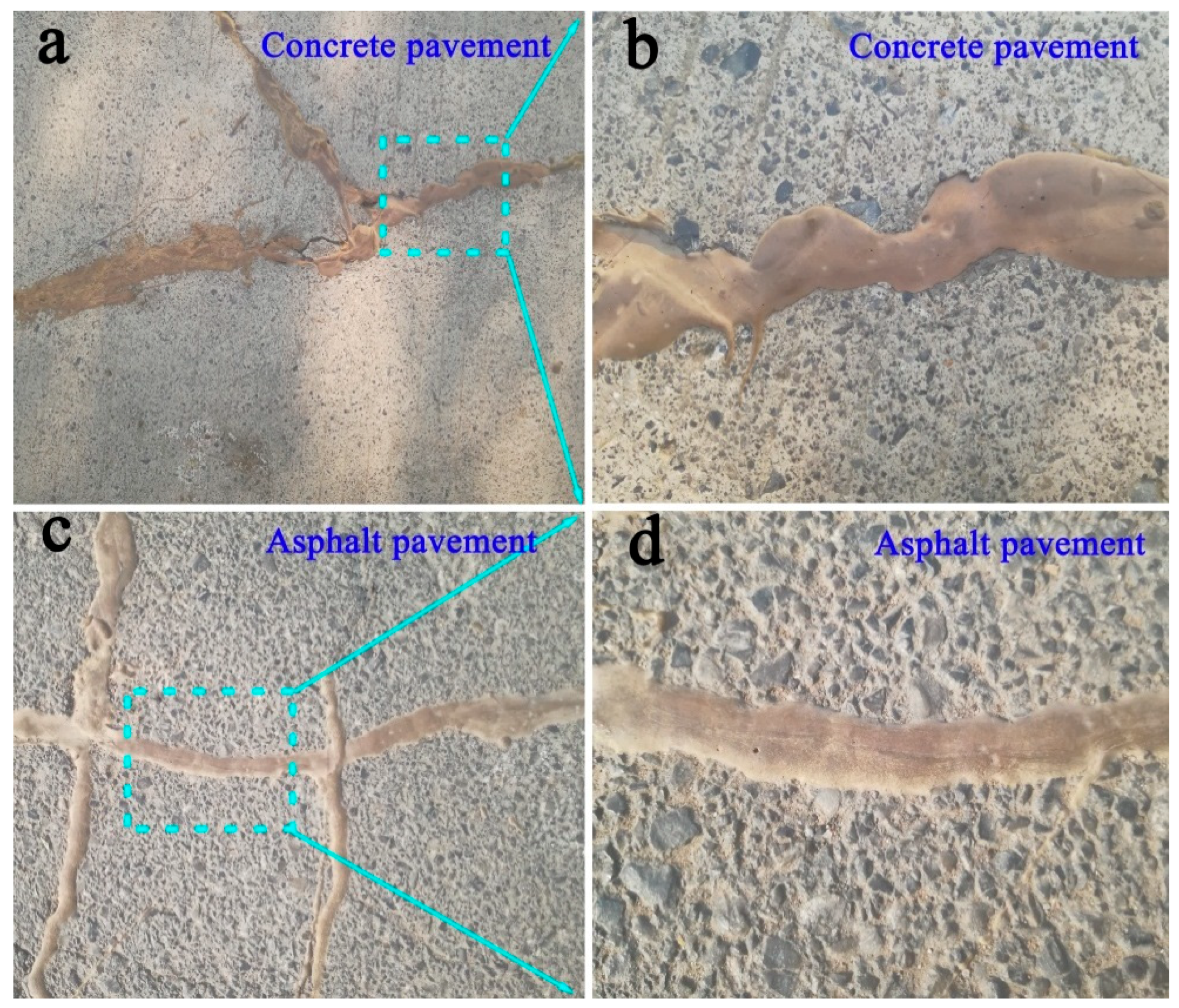
© 2018 by the authors. Licensee MDPI, Basel, Switzerland. This article is an open access article distributed under the terms and conditions of the Creative Commons Attribution (CC BY) license (http://creativecommons.org/licenses/by/4.0/).
Share and Cite
Zhang, C.; Shuai, B.; Zhang, X.; Hu, X.; Zhang, H.; Jia, Y.; Yang, Z.; Guan, X. Polyurethane/Red Mud Composites with Flexibility, Stretchability, and Flame Retardancy for Grouting. Polymers 2018, 10, 906. https://doi.org/10.3390/polym10080906
Zhang C, Shuai B, Zhang X, Hu X, Zhang H, Jia Y, Yang Z, Guan X. Polyurethane/Red Mud Composites with Flexibility, Stretchability, and Flame Retardancy for Grouting. Polymers. 2018; 10(8):906. https://doi.org/10.3390/polym10080906
Chicago/Turabian StyleZhang, Chunjing, Bo Shuai, Xuefeng Zhang, Xinxin Hu, Hui Zhang, Yuanheng Jia, Zhengpeng Yang, and Xuemao Guan. 2018. "Polyurethane/Red Mud Composites with Flexibility, Stretchability, and Flame Retardancy for Grouting" Polymers 10, no. 8: 906. https://doi.org/10.3390/polym10080906
APA StyleZhang, C., Shuai, B., Zhang, X., Hu, X., Zhang, H., Jia, Y., Yang, Z., & Guan, X. (2018). Polyurethane/Red Mud Composites with Flexibility, Stretchability, and Flame Retardancy for Grouting. Polymers, 10(8), 906. https://doi.org/10.3390/polym10080906



